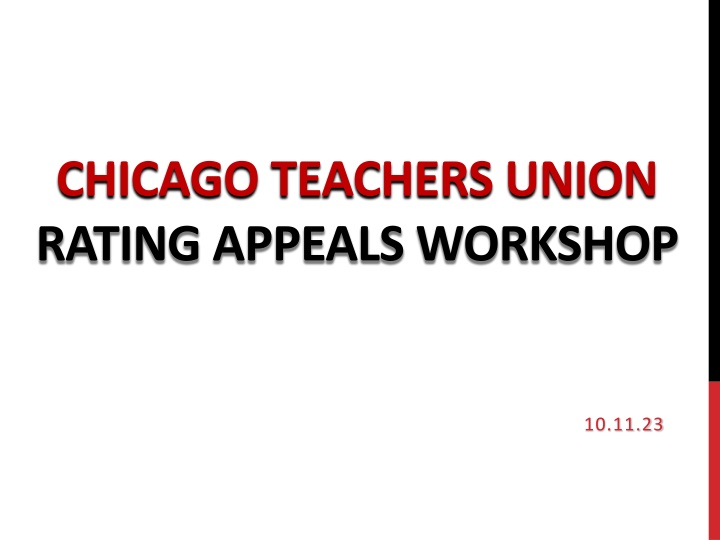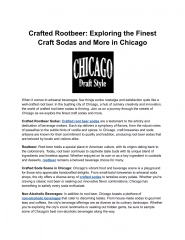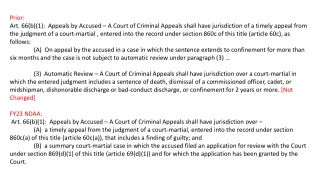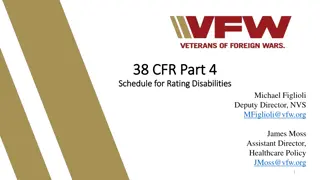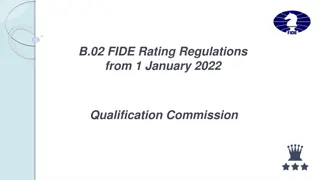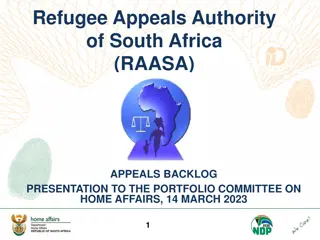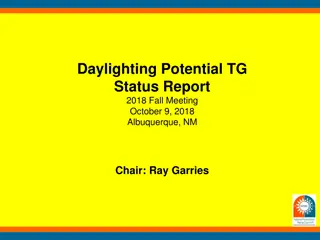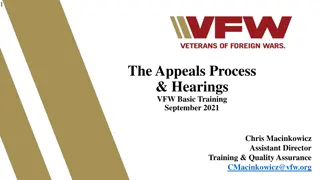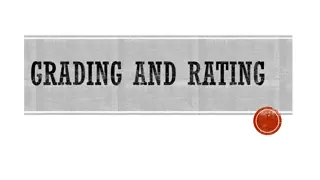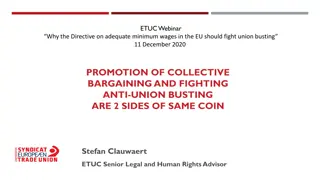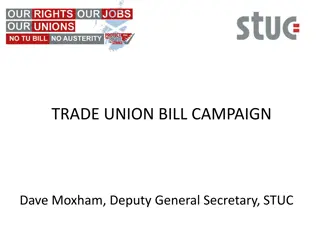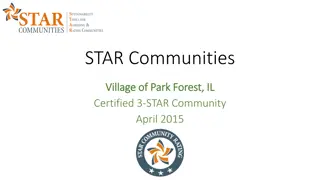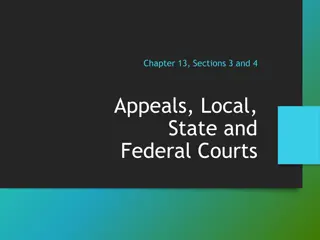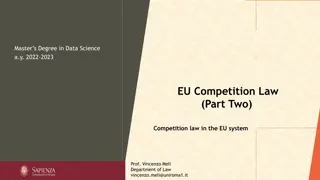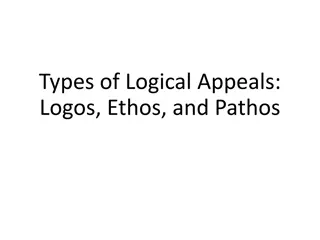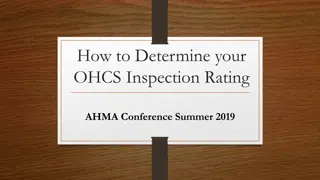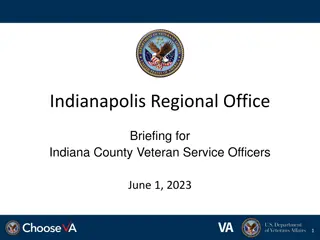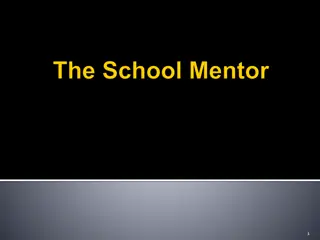Chicago Teachers Union Rating Appeals Workshop
The Chicago Teachers Union Rating Appeals Workshop focuses on resources, grievance vs. appeals, appeals process, premises for an appeal, timelines, and more. It covers important dates, criteria for appeals, and potential outcomes. Educators can learn about navigating the appeal process effectively to challenge evaluation ratings.
Download Presentation

Please find below an Image/Link to download the presentation.
The content on the website is provided AS IS for your information and personal use only. It may not be sold, licensed, or shared on other websites without obtaining consent from the author.If you encounter any issues during the download, it is possible that the publisher has removed the file from their server.
You are allowed to download the files provided on this website for personal or commercial use, subject to the condition that they are used lawfully. All files are the property of their respective owners.
The content on the website is provided AS IS for your information and personal use only. It may not be sold, licensed, or shared on other websites without obtaining consent from the author.
E N D
Presentation Transcript
CHICAGO TEACHERS UNION RATING APPEALS WORKSHOP 10.11.23
AGENDA 1. Resources 2. Grievance versus Appeals 3. Rating Appeals Process 4. Appeals Overview 5. Appeals Premises 6. Appeals Case Examples 7. Q&A 2
RESOURCES 1. CPS RLS Full Appeal and Intent to Appeal Instructions link 2. Appeals Evidence Template link 3. Framework for Teaching with Critical Attributes link 4. Appeals Checklist link 5. Teacher Evaluation Handbook link 6. Article 39 Contract Language link 7. CTU Grievance Checklist link 8. Grievance Authorization Form link 9. Documentation Guide link 3
GRIEVANCE VS APPEALS Grievances address Article 39 procedural violations for evaluation. 1. 2. 3. Use the Grievance Checklist to assess violations. Contact your CTU Field Representative to complete the process. Grievances are due by December 1, 2023. Appeals challenge the content of the evaluation. Who can appeal? Anyone who received an unsatisfactory; Tenured educators with low developing (250 or below); Educators with developing that led to layoff out of seniority order. 4
TIMELINE OVERVIEW 1: Intent to Appeal You have 10 calendar days after receiving the summative rating on RLS to file an Intent to Appeal. The due date was Friday, October 6, 2023. 2: Evidence for Appeal The educator has a total of 30 calendar daysafter receiving the summative rating on RLS to submit Evidence on RLS. The due date is Thursday, October 26, 2023 by 5:00 p.m. 3: Appeals Review Appeals are reviewed by an Appeals panel (two retired teachers, two retired administrators). The appeals panel may choose to interview the educator (who has a right to union representation) as well as the evaluator. After reviewing the appeal, the panel will vote to grant the appeal (votes of 4-0 or 3-1) or deny the appeal. The Appeals process will take a few months to conclude. 5
TIMELINE OVERVIEW CONT. 4. If your appeal is granted: The SY 22-23 rating is removed from your record. Ratings 250 or lower will be issued a Developing rating with a score of 284 for SY 22-23. Ratings 251 -284 will be issued a 285 Proficient rating for SY 22-23. If you were laid off, the layoff may be reversed. If you are a non-renewed PAT your non-renewal stands even if the appeal is won. If you are tenured with an Unsatisfactory rating, the Remediation plan will end and a Professional Development Plan will be put in place. A different qualified evaluator will conduct your observations for the remainder of the school year. 6
PREMISES FOR AN APPEAL 1. Evidence used by evaluator doesn t match component scoring. 2. Evidence used by evaluator is missing or not considered. 3. Teacher did not have the opportunity to contribute their thoughts during pre- or post-observation conferences. 4. Student particularities and/or classroom needs were not addressed by evaluator. 5. Ratings are based on observation notes that reflect evaluator bias, subjectivity, or interpretation. 6. Evaluator is biased (as shown by specific statements and/or actions). 7. Other. 7
BUILDING AN APPEALS CASE The strongest Appeals will address multiple component scores from each observation that do not correspond to the descriptors in the Framework. All REACH Frameworks can be found on the CTU website - link You should align your supporting evidence for each premise and each component scores you are challenging. Be sure to provide thorough explanations of your evidence. You may need to upload documents like student work, lesson plans or other document to demonstrate why a particular observation score was inappropriate. Additional documents demonstrating evaluator s bias may exist outside of RLS (i.e. emails, other feedback, notes from conversations, etc).
Evidence Template Premise(evidence doesn t match scores, missing evidence, special class considerations, etc.): Observation Date: Component(s): Additional Evidence: (Documents to attach) Evidence: Explanation/Connection to Framework(include specific language from the framework/ critical attributes): 9
STEP BY STEP 1. Chose a component to challenge. 2. Use Appeals Evidence Template as a guide. You can write directly on the template, use the electronic version, or type in your own document. Make sure you include evidence and explanation! 3. Use the Framework with Critical Attributes to prove that your evidence deserves a higher score. Use language from the framework in your explanation. Make the connection between your evidence and the framework.
EVIDENCE TIPS Use your Professional Practice Summary to identify low component scores to challenge. Use the CPS Framework with Critical Attributes or your relevant Framework. Use Relevant Addendum (Arts, P.E., Special Education, ELL, Pre-K-2nd) Use the Appeals Evidence Template and the Appeals Checklist to ensure a complete appeal. Ask a trusted colleague to help you compile your evidence. Additional documents demonstrating evaluator s bias can also be uploaded (i.e. emails, notes from conversations, etc.) 11
EVIDENCE CONT. You can challenge scores from anyand allobservations included in this rating. This may include observations from 2021-22 if you were on a 2-year cycle. If your Unsatisfactory is based on 2 Developing ratings, you can challenge observations from both developing ratings, which might include 2021-22 as well as 2022-23. You do not need to challenge every low score. Choose the ones you have strong evidence for.
Example 1 Observation Date: 11/16/2015 Component: 3b Premise: Missing Evidence Evaluator did not record everything occurring in the classroom. Evidence: My principal said that I wasn t teaching, just watching students do group work. His observation notes do not reflect that I was walking from group to group speaking with the students and that several times I called on students and allowed them to ask a question to the whole class I thought would help everyone. Additional Evidence: (Documents to attach) - Lesson plan for this date; - student work samples (if available) or blank copy of group assignment. Explanation / Connection to Framework: The description for Proficient for Component 3b states, Teacher creates a genuine discussion among students... Most students are listening and responding to questions and answers from their teacher and peers. Teacher ensures that most voices are heard in the discourse. As a result of working in groups, all students were able to engage in authentic discussions about the content. All students were listening and responding to their peers in their small groups, and ensuring that everyone had a voice. I also engaged with every student at some point in the class. Therefore, my 3b component score for this observation should be Proficient. 13
Example 2 Observation Date: 04/22/2016 Component: 1b Premise: Administrator did not allow opportunity for me to contribute during pre-observation conference. Evidence: The Administrator only allowed fifteen minutes for my pre-conference. In our conversation, she didn t even refer to the answers to the pre-conference questions I had uploaded and sent her via email two days in advance. When I tried to explain how I would be handling the behavior of a few of my SPED students in class based on their IEP s, she told me to stop making excuses for poor classroom management. Additional Evidence: (Documents to attach) - Lesson plan for this observation, including differentiation & accommodations Explanation / Connection to Framework: The critical attributes for 1b Proficient include: teacher is aware of the needs of diverse learners and applies this knowledge to plan differentiated instruction and lesson plans are appropriate for the whole class and are also modified for specific groups of students based on teacher knowledge of various student characteristics. I clearly demonstrated this in my lesson plan and was not given the opportunity to discuss this during my pre-observation conference. 14
WHAT NOT TO DO Refer to emails or documents(lesson plans, student work, etc.) without uploading them. Claim biaswithout citing specific examples, providing documentation, or explaining how this reflects bias toward you as an individual educator. Fail to refer to particular components of specific observations. Fail to align your evidence to the framework. State that you deserved a distinguished rating. Challenge every score without providing solid evidenceor explanations. 15
FOR A STRONG APPEAL Prove the premise and show how this affected your scores. Include documents and evidence in your appeal in RLS: unit/lesson plans, student work, relevant emails. Organize and label your appeal and any uploaded documents. Explain and document any claims of bias, including: the nature of the bias (reason) the specific instances that is demonstrated in the observer s narrative, emails, or in the pre/post-conference. Connect evidence to the framework that is at least proficient. Document, Document, Document! 16
WINNING APPEAL EXAMPLE Eligible Educator: Counselor/Case Manager Premise: 2. Missing evidence or evidence not considered. Component: 3A on ESS Framework 3A: Collaborating with adults regarding instruction/service delivery for students and/or adults Evidence/Explanation: During our debrief discussion I was marked down for projecting [an]IEP. I was told it was too visually stimulating while talking. Best practice and following procedural safeguards is to provide a parent a copy of the IEP draft while the meeting is taking place so the process is transparent. Another area I was marked down to basic was because the parent did not ask any questions. I opened the meeting stating, This is a working meeting and you know your child best. Please feel free to interrupt or ask any questions as we go. My goal is for us to all feel comfortable with the plan being put in place for your child. I was told it was my fault parents didn t ask questions because I have not established good relationships with them. Additional Evidence: Article showing importance of displaying IEP at meeting
WINNING APPEAL EXAMPLE Premise: 1. Evidence doesn t matching scoring. Component: 3C on Framework for Teaching 3C: Engaging Students in Learning Evidence/Explanation: The following are from the observer s notes: Classroom is print rich. Many anchor charts that exhibit lessons taught. All students come to the work table. After the instruction at the work table: Teacher asks guiding questions as students pause during the reading. Students on the rug doing the activity together. Teacher uses two different reading texts to place students for the science reading assignment. All students complete the assigned worksheet. [Evaluator s] evidence indicates the students were engaged in the learning process through their listening and actions, which aligns with "Proficient" for 3C. 18
EVIDENCE OF EVALUATOR BIAS Premise: Ratings are based on observation notes that reflect evaluator bias, subjectivity, or interpretation. Evaluator s observation notes contain partial classroom dialogue and fails to describe teacher and student activity such as grouping, students assisting one another, formative assessment, feedback provided, questioning, etc. Evaluator only recorded one side of the classroom dialogue be it teacher or student voice. Evaluator uses language that is clearly subjective or exaggerated. Evaluator commented on personal factors not relevant to teaching or the Framework, such as educator's appearance, voice, etc. Premise: Evaluator is biased. Evaluator s remarks reflect racial, gender, age, or other illegal factors. (Reflected in observation notes, emails, or documented conversations). 19
DROP-IN SUPPORT SESSIONS Rating Appeals Drop-in Support Sessions will be held on the following days from 4:00 p.m. 6:00 p.m. at the CTU Center (1901 W Carroll Ave). Monday, October 16, 2023 Tuesday, October 17, 2023 NO RSVP Needed *BRING YOUR LAPTOPS! Appeals are due October 26 by 5 p.m.! 20
Q&A 21
